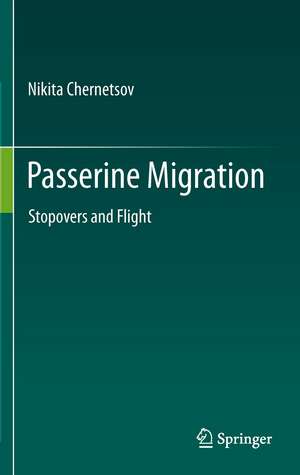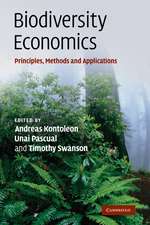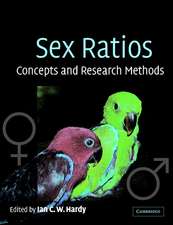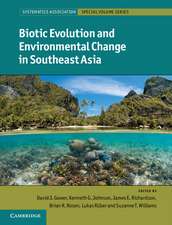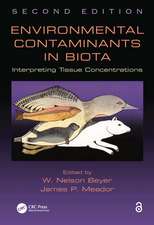Passerine Migration: Stopovers and Flight
Autor Nikita Chernetsoven Limba Engleză Paperback – 8 mai 2014
| Toate formatele și edițiile | Preț | Express |
|---|---|---|
| Paperback (1) | 776.81 lei 38-45 zile | |
| Springer Berlin, Heidelberg – 8 mai 2014 | 776.81 lei 38-45 zile | |
| Hardback (1) | 944.19 lei 6-8 săpt. | |
| Springer Berlin, Heidelberg – 18 apr 2012 | 944.19 lei 6-8 săpt. |
Preț: 776.81 lei
Preț vechi: 1022.12 lei
-24% Nou
Puncte Express: 1165
Preț estimativ în valută:
148.64€ • 155.19$ • 123.02£
148.64€ • 155.19$ • 123.02£
Carte tipărită la comandă
Livrare economică 31 martie-07 aprilie
Preluare comenzi: 021 569.72.76
Specificații
ISBN-13: 9783642433283
ISBN-10: 3642433286
Pagini: 196
Ilustrații: XII, 184 p.
Dimensiuni: 155 x 235 x 10 mm
Greutate: 0.29 kg
Ediția:2012
Editura: Springer Berlin, Heidelberg
Colecția Springer
Locul publicării:Berlin, Heidelberg, Germany
ISBN-10: 3642433286
Pagini: 196
Ilustrații: XII, 184 p.
Dimensiuni: 155 x 235 x 10 mm
Greutate: 0.29 kg
Ediția:2012
Editura: Springer Berlin, Heidelberg
Colecția Springer
Locul publicării:Berlin, Heidelberg, Germany
Public țintă
ResearchCuprins
Foreword.- Introduction.- 1. Stopover duration, 1.1. Methods of estimating stopover duration, 1.2. Estimates based on re-encounters of marked birds, 1.3. Estimates based on radio-tagging, 1.4. Within-species variance in stopover duration: ‘transients’ and ‘non-transients’, 1.5. Concluding remarks.- 2. Fuel deposition rate and energy efficiency of stopovers, 2.1. Energy stores of migrants, 2.2. Methods of estimating fuel deposition rate, 2 .3. Empirical FDR values, 2.4. Factors that influence FDR, 2.5. Low initial FDR: an artefact or real phenomenon?.- 3. Optimal migration theory, 3.1. General remarks, 3.2. Time minimisation, 3.3. Minimisation of energy cost of migration, 3.4. Predation risk minimisation, 3.5. Basic equations, 3.6. Concluding remarks.- 4. Habitat selection and use by migrants, 4.1. Introductory remarks, 4.2. Scales of habitat selection at stopover, 4.3. Role of individual experience, 4.4. Termination of migratory flights, 4.5. Search for home range and settling, 4.6. Habitat exploitation,4.7. Fuel deposition in oases, 4.8. Fuel deposition on islands.- 5. Spatial behaviour at stopovers, 5.1. Introductory remarks, 5.2. Range and direction of daytime movements of nocturnal migrants, 5.3. Restricted home ranges vs. broad movements:visual observations and recapture analysis, 5.4. Spatial behaviour at stopovers: radio-tracking data, 5.5. Impact of fuel stores on spatial behaviour, 5.6. Spatial behaviour of songbird migrants at stopover and spatial distribution of food.- 6. Temporal pattern and energy cost of migratory flight, 6.1. Time of nocturnal migratory departures, 6.2. Body mass and fuel stores at nocturnal migratory departure, 6.3. Nocturnal departures of lean birds and reverse migration at night, 6.4. Relationship between fuel stores and take-off time, 6.5. Time of ceasing flight, 6.6. Body mass at arrival after migratory flights, 6.7. Estimates of energy costs of migratory flight.- 7. Migratory flights and stopovers: organisation of migration, 7.1. Theoretically possible fuel deposition rate, 7.2. Factors that influence departure decisions, 7.3. Series of migratory flights and waves of passage, 7.4. Spring vs. autumn migration, 7.5. Migration of a typical long-distance passerine nocturnal migrant.- Conclusions.- References
Textul de pe ultima copertă
This monograph summarizes the results of studying passerine migration, mainly that of long-distance nocturnal migrants. Migratory stopovers and migratory flights are shown to be closely interconnected. The main quantitative parameters of stopovers, i.e., their duration, fuel deposition rate and overall energy efficiency, govern the potntial range of migratory flights. The quantitative energetic parameters of stopovers should not be studied separately from the stopover behaviour of birds, especially from their habitat selection and use and their spatial behaviour. The energy costs of migratory flight in species adapted for migration are significantly lower than hitherto assumed. A critique of optimal migration theory is presented and a qualitative model of stopover behaviour of migrating passerines is put forward.
The monograph represents a valuable resource for ornithologists, zoologists, ecologists, conservationists, and students of biology.
The monograph represents a valuable resource for ornithologists, zoologists, ecologists, conservationists, and students of biology.
Caracteristici
This monograph is the first attempt to summarize and critically review the vast literature on stopover ecology and behaviour of songbirds
Includes supplementary material: sn.pub/extras
Includes supplementary material: sn.pub/extras
